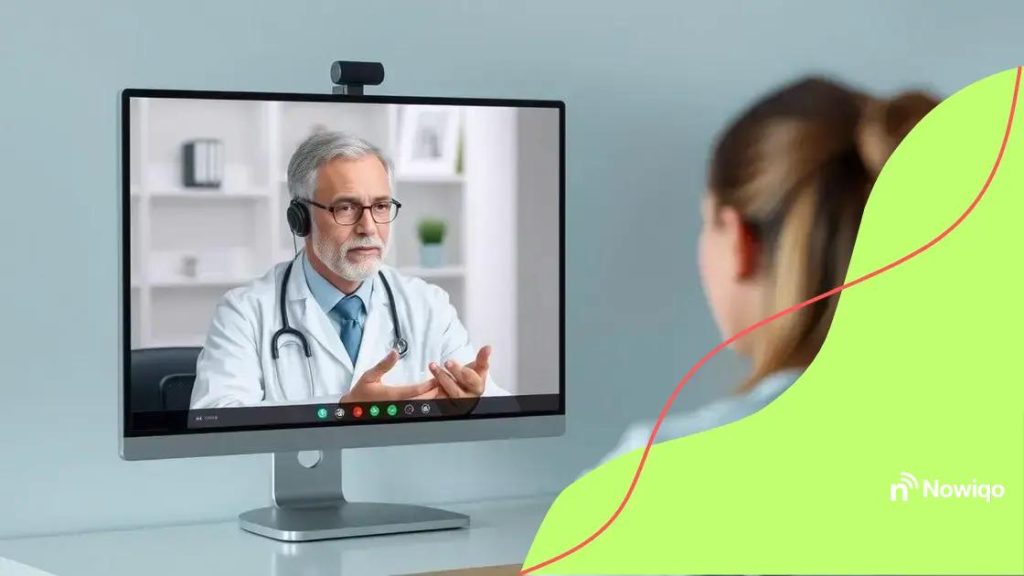Telemedicine expansion 2025: revolutionizing healthcare access

Anúncios
Telemedicine expansion by 2025 will enhance healthcare access through advanced technology integration, broader specialty adoption, and improved patient engagement, despite challenges such as regulations and technology barriers.
Telemedicine expansion 2025 is on the horizon, promising to reshape how we approach healthcare. Have you ever wondered how it could change your doctor visits or access to specialists? Let’s delve into this evolving landscape.
Anúncios
What is telemedicine?
Telemedicine is a growing field that allows patients to access healthcare services remotely. Rather than visiting a doctor in person, patients can connect with their healthcare providers from the comfort of their homes. This innovation is especially valuable for those who may have difficulty traveling to appointments due to distance or health issues.
Definition and Overview
In simple terms, telemedicine means using technology to deliver medical care and services from a distance. It includes various healthcare services, such as consultations via video calls, mobile health apps, and remote patient monitoring.
How Telemedicine Works
The process of telemedicine typically involves a few straightforward steps:
Anúncios
- Patients make an appointment through a website or app.
- They attend their appointment through a video call or chat.
- Doctors assess their health issues and provide advice or treatment.
This convenience means that patients can receive care quickly without having to wait weeks for an in-person visit. As a result, many people are increasingly turning to telemedicine for their primary healthcare needs.
Additionally, it aids in reducing the burden on healthcare facilities and allows doctors to reach more patients efficiently. Barriers that once limited access to healthcare, especially in underserved areas, are decreasing.
Benefits of Telemedicine
- Improved access to healthcare services.
- Immediate consultations for urgent issues.
- Increased convenience and time savings for patients.
- Better management of chronic diseases through regular remote monitoring.
Overall, telemedicine is transforming how we think about healthcare, making it more accessible and user-friendly.
Key trends driving telemedicine expansion
The expansion of telemedicine is fueled by several key trends. These trends highlight how healthcare is evolving in response to technology and patient needs. As more people embrace digital solutions, healthcare providers are adapting to meet these demands.
Increased Use of Technology
Advancements in technology are a major force behind the growth of telemedicine. The rise of smartphones and high-speed internet allows patients to connect easily with healthcare providers. Today, a simple app can facilitate consultations, prescriptions, and follow-up care.
Patient Demand for Convenience
Patients today expect convenience and speed in receiving healthcare. With busy lifestyles, many prefer telemedicine as it saves time and reduces travel. This shift means that healthcare providers must offer services that fit into patients’ schedules.
- Immediate consultations for common illnesses.
- Easy access to specialists without long waiting times.
- Reduced need for in-person visits unless necessary.
The flexibility of telemedicine not only benefits patients but also helps healthcare systems become more efficient. By minimizing the need for physical visits, doctors can see more patients in less time.
Focus on Chronic Disease Management
Chronic diseases require ongoing management, and telemedicine provides an effective solution. Regular check-ins through video calls and monitoring devices help patients stay on track with their treatments. This ongoing engagement leads to better health outcomes and increased patient satisfaction.
Moreover, the data collected through remote monitoring can help doctors make informed decisions regarding treatment adjustments. This proactive approach is key to enhancing patient care.
- Regular updates on patient health status.
- Timely interventions for potential complications.
- Greater access to educational resources for managing diseases.
As we look to the future, these trends are likely to persist, driving the continued expansion of telemedicine and transforming how healthcare is delivered.
Benefits of telemedicine for patients and providers

The rise of telemedicine offers numerous benefits for both patients and healthcare providers. This innovative approach to healthcare is reshaping the way medical services are delivered, making them more efficient and accessible.
Convenience for Patients
One of the most significant advantages of telemedicine is the convenience it provides. Patients can schedule appointments easily and connect with their doctors from anywhere. This eliminates the need for long drives or waiting in crowded waiting rooms.
Increased Access to Specialists
Telemedicine breaks down geographical barriers, allowing patients to consult specialists without needing to travel. This is especially beneficial for those in rural or underserved areas. Patients no longer have to wait weeks for a specialist appointment, as they can connect virtually.
- Faster appointments for timely care.
- Less travel time and related expenses.
- Access to a wider range of specialists.
This rapid access ensures that patients receive timely advice and treatment, which can lead to better health outcomes. As a result, telemedicine empowers patients to take control of their health.
Cost-Effectiveness
For both patients and providers, telemedicine can also be more cost-effective. Patients save money on transportation and time off work. Providers can reduce overhead costs related to in-office visits, such as facilities and staffing. This efficiency allows them to allocate resources more effectively.
- Lower patient expenses.
- Reduced administrative costs for providers.
- More flexible payment models.
The financial benefits make telemedicine an attractive option for many patients and healthcare systems. Moreover, these savings can lead to more frequent check-ups and follow-ups, promoting better long-term health management.
Improved Patient Engagement
Telemedicine encourages stronger patient engagement by making healthcare more accessible. Patients can reach out to their providers with questions or concerns at any time, fostering better communication. This open dialogue leads to improved adherence to treatment plans.
Additionally, many telemedicine platforms provide educational resources to help patients manage their health effectively. The combination of regular check-ins and easy access to information ensures patients stay informed and engaged in their care journey.
Overall, the benefits of telemedicine significantly enhance the healthcare experience for patients and providers alike, contributing to a more effective healthcare ecosystem.
Challenges facing the telemedicine industry
The telemedicine industry faces several challenges that can impact its growth and effectiveness. Understanding these challenges is essential for improving services and ensuring that patients receive quality care.
Regulatory Hurdles
One of the significant challenges is the complex regulatory landscape. Telemedicine regulations vary by state and country, making it difficult for providers to navigate rules. This inconsistency can lead to confusion and limit providers’ ability to offer services across borders efficiently.
Technology Barriers
Another challenge is the reliance on technology. While advancements have made telemedicine possible, not everyone has access to the necessary devices or stable internet connections. Patients in rural areas or low-income situations may struggle with these technology barriers, limiting their access to telemedicine services.
- Lack of internet access can hinder patient participation.
- Older patients may not be comfortable using technology.
- Not all platforms offer user-friendly interfaces.
As a result, healthcare providers must find solutions to ensure that all patients can benefit from telemedicine, regardless of their technological capabilities.
Privacy and Security Concerns
Privacy and security issues are also at the forefront of telemedicine challenges. Protecting patient data is crucial, yet the increase in digital interactions raises the risk of breaches. Patients need to trust that their sensitive information stays safe when they consult with healthcare providers online.
Healthcare organizations must continually invest in robust cybersecurity measures to safeguard data. Educating both providers and patients about security practices is vital in building this trust.
- Data encryption and secure login protocols are essential.
- Regular audits can help identify vulnerabilities.
- Patient education on privacy tips is crucial.
Addressing these privacy concerns is necessary for telemedicine to flourish and for patients to feel confident in using remote healthcare services.
Insurance Coverage Issues
Another issue that affects the expansion of telemedicine is the variability in insurance coverage. Not all insurance providers reimburse telemedicine services, which can discourage both patients and providers from utilizing these options.
Many patients may still prefer in-person visits simply because they are unsure if their insurance will cover a virtual appointment. Providers, on the other hand, might hesitate to invest in telemedicine technologies without assurances of reimbursement.
Improving coverage policies and aligning reimbursement standards with traditional healthcare will be vital for promoting the adoption of telemedicine.
Future predictions for telemedicine by 2025
As we look ahead, the future of telemedicine seems bright, with exciting predictions for 2025. With technological advancements and changing consumer expectations, the landscape of healthcare will continue to evolve rapidly.
Enhanced Technology Integration
By 2025, we can expect even greater integration of advanced technologies in telemedicine. Artificial intelligence and machine learning will become more common, helping healthcare providers analyze patient data more efficiently. This will lead to more personalized treatment plans based on individual health needs.
Increased Patient Engagement
Patients are likely to become more engaged in their healthcare journeys. With the rise of mobile health applications, individuals will be able to track their health data and communicate with their providers more easily. This engagement encourages proactive health management and improved health outcomes.
- Patients will have greater access to their health information.
- Health apps will support self-management of conditions.
- Real-time feedback will enhance the consultation process.
As a result, the bond between patients and providers will strengthen, fostering a collaborative approach to health.
Broader Adoption Across Specialties
The expansion of telemedicine is not limited to primary care. By 2025, more specialties will adopt this method of care. Fields like mental health, dermatology, and chronic disease management are already seeing increased utilization of telehealth services. This trend will only continue, allowing patients access to more specialized care without geographical limitations.
- Specialists will offer virtual consultations.
- New service types will emerge, focusing on specific health needs.
- Access to rare specialists will improve for remote patients.
Such diversity in services will offer patients more choices, improving their overall healthcare experience.
Focus on Mental Health Services
A significant shift is expected in the realm of mental health services through telemedicine. The stigma surrounding mental health is declining, and virtual therapy options are becoming widely accepted. By 2025, teletherapy is predicted to be a common practice, making mental health support more accessible to those in need.
This accessibility will encourage more individuals to seek help, ultimately contributing to better mental health outcomes across communities. The development of online support groups and mental wellness applications will also support this trend.
telemedicine is reshaping the healthcare landscape by making services more accessible and convenient for patients. With advancements in technology and a focus on patient engagement, the future looks promising. By 2025, we expect to see wider adoption across various specialties and improved mental health services. However, challenges such as regulations and technology barriers remain. Addressing these issues will pave the way for more effective telemedicine solutions that benefit everyone.
FAQ – Frequently Asked Questions about Telemedicine Expansion
What are the main benefits of telemedicine for patients?
Telemedicine offers patients convenience, increased access to specialists, and the ability to manage their health from home.
How is technology impacting telemedicine?
Technology enables seamless communication between patients and providers, integrating advanced tools like AI for personalized care.
What challenges does the telemedicine industry face?
Challenges include regulatory hurdles, technology barriers, privacy concerns, and insurance coverage variability.
What are the predictions for telemedicine by 2025?
By 2025, we expect greater technology integration, increased patient engagement, broader specialty adoption, and a focus on mental health services.